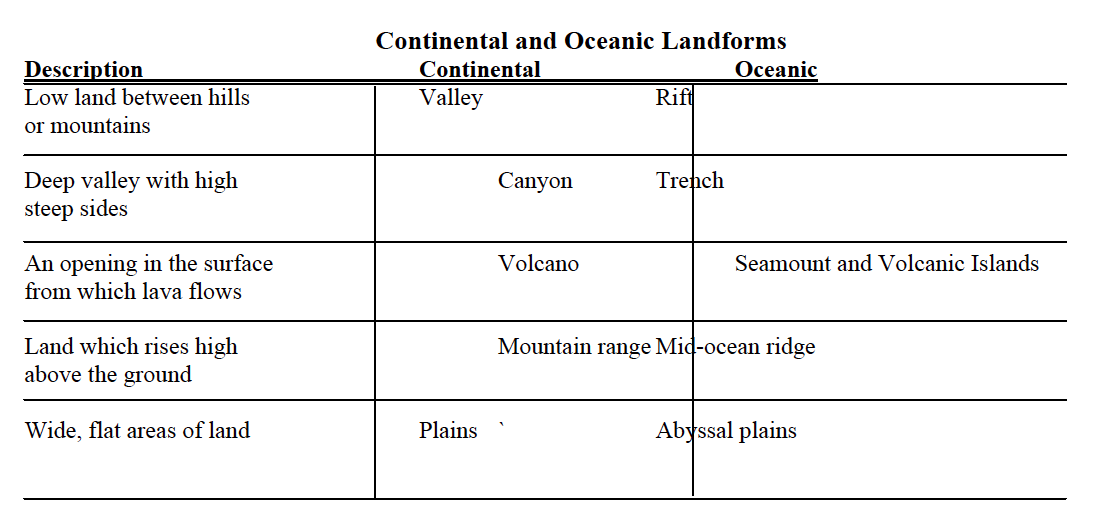Landforms Webquest
Landforms
You are a space alien and you have just discovered earth. It is a clear, sunny day and you are looking out your windows. What will you see? You will see many things but let's concentrate on shapes that make up the earth’s surface. What do you think the shapes will be of? The shapes will be of forms of land and bodies of water. Let's take a closer look at the landforms that you might see as you look out the window.
Introduction:
What is a landform? How many different landforms are found on Earth? What are some of these landforms?
Do you know how each of these landform regions developed? Was it the result of constructive forces or destructive Earth forces?
The purpose of this project is to learn about landforms and to understand how they developed.
You are a space alien and you have just discovered earth. It is a clear, sunny day and you are looking out your windows. What will you see? You will see many things but let's concentrate on shapes that make up the earth’s surface. What do you think the shapes will be of? The shapes will be of forms of land and bodies of water. Let's take a closer look at the landforms that you might see as you look out the window.
Introduction:
What is a landform? How many different landforms are found on Earth? What are some of these landforms?
Do you know how each of these landform regions developed? Was it the result of constructive forces or destructive Earth forces?
The purpose of this project is to learn about landforms and to understand how they developed.
Tasks:
Your task is to work with your group to research 4 landforms- 2 on land and 2 under the ocean. Each person within the group should be given a specific task to complete. Once that task has been completed, the group must develop PowerPoint slides to be part of a PowerPoint presentation developed by the entire group on landforms with Office 365.
Your task is to work with your group to research 4 landforms- 2 on land and 2 under the ocean. Each person within the group should be given a specific task to complete. Once that task has been completed, the group must develop PowerPoint slides to be part of a PowerPoint presentation developed by the entire group on landforms with Office 365.
Task One:
Research the characteristics of 4 landforms. Develop PowerPoint slides that explain each of these and where they
can be found. (No more than one landform per slide) Research whether constructive forces, destructive forces, or both forces created each of these landforms. Make sure your PowerPoint slides explain how you know this. Don't let your brain be LAZY. You will have to carefully scan and read a lot to find the information you want.
Research the characteristics of 4 landforms. Develop PowerPoint slides that explain each of these and where they
can be found. (No more than one landform per slide) Research whether constructive forces, destructive forces, or both forces created each of these landforms. Make sure your PowerPoint slides explain how you know this. Don't let your brain be LAZY. You will have to carefully scan and read a lot to find the information you want.
Task Two (optional):
Create a voice over for each slide-if time permits. Every person in the group must speak at some point in the presentation.
If one or more team members complete their tasks earlier than the others, they may work to add extra information, graphics, etc. to the PowerPoint presentation. You will also need one slide with your sources.
Create a voice over for each slide-if time permits. Every person in the group must speak at some point in the presentation.
If one or more team members complete their tasks earlier than the others, they may work to add extra information, graphics, etc. to the PowerPoint presentation. You will also need one slide with your sources.
Process:
1. Each group will research four landforms and take notes on the characteristics of each landform. These notes will be used to create PowerPoint slides on the characteristics of each landform. These students will be creating a presentation with at least four entries--one each of the 4 different kinds landforms. The student will need to find
pictures of each landform on Internet or by scanning them from books, magazines, etc. Each slide on a landform should contain at least one picture of a characteristic of that landform and how they were created constructive or destructive or both.
1. Each group will research four landforms and take notes on the characteristics of each landform. These notes will be used to create PowerPoint slides on the characteristics of each landform. These students will be creating a presentation with at least four entries--one each of the 4 different kinds landforms. The student will need to find
pictures of each landform on Internet or by scanning them from books, magazines, etc. Each slide on a landform should contain at least one picture of a characteristic of that landform and how they were created constructive or destructive or both.
Internet Resources
1. http://www.worldatlas.com/webimage/countrys/namerica/usstates/sc.htm
2. http://www.teachersfirst.com/share/states/detail-land.cfm?state=sc
3. http://sciway2.net/2001/sc-geology/blue_ridge.htm
4. http://www.clas.ufl.edu/users/adkinss/Piedmont.pdf
5. http://www.parcplace.org/education/pdf/Sandhills.pdf
6. http://www.e-referencedesk.com/resources/state-geography/south-carolina.html
7. http://www.rickriordan.com/types_of_landforms.htm
8. http://www.harcourtschool.com/activity/types_of_land_2/index.html
9. http://www.edu.pe.ca/southernkings/landforms.htm
10. http://www.enchantedlearning.com/geography/landforms/
11. http://eliot.needham.k12.ma.us/technology/lessons/landforms/landforms.html
12. http://www.wacona.com/promote/galandforms/destructive.htm
13. http://www.wacona.com/promote/galandforms/constructive.htm
1. http://www.worldatlas.com/webimage/countrys/namerica/usstates/sc.htm
2. http://www.teachersfirst.com/share/states/detail-land.cfm?state=sc
3. http://sciway2.net/2001/sc-geology/blue_ridge.htm
4. http://www.clas.ufl.edu/users/adkinss/Piedmont.pdf
5. http://www.parcplace.org/education/pdf/Sandhills.pdf
6. http://www.e-referencedesk.com/resources/state-geography/south-carolina.html
7. http://www.rickriordan.com/types_of_landforms.htm
8. http://www.harcourtschool.com/activity/types_of_land_2/index.html
9. http://www.edu.pe.ca/southernkings/landforms.htm
10. http://www.enchantedlearning.com/geography/landforms/
11. http://eliot.needham.k12.ma.us/technology/lessons/landforms/landforms.html
12. http://www.wacona.com/promote/galandforms/destructive.htm
13. http://www.wacona.com/promote/galandforms/constructive.htm

